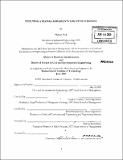Evolving a global armaments logistics strategy
Author(s)
Peck, Nathan (Nathan W.)
DownloadFull printable version (28.61Mb)
Other Contributors
Leaders for Manufacturing Program.
Advisor
Stephen C. Graves and David Simchi-Levi.
Terms of use
Metadata
Show full item recordAbstract
Few companies globally source and manage commercial transportation for frequent and high volumes of explosive cargo for the U. S. Department of Defense. U.S. regulations are strict and economically competitive options are limited. The challenge is even more problematic when the company has not developed an internal capability to efficiently manage logistics transportation. Companies view logistics and supply chain management as crucial to their overall success, though most do not claim it as a core competency. Instead, companies often outsource logistics operations and management to 3rd Party Logistics and other transportation solution providers. This paper explores how a company dealing with frequent shipments of explosive, Department of Defense cargo need not fully outsource logistics operations and management. Rather this paper shows how a company can quickly and cost-effectively improve their internal logistics capability while utilizing the benefits of logistics outsourcing. It is imperative that a company evolving its logistics capability maintain flexibility yet realize the advances in the transportation outsourcing industry. This research is distinctive in that it provides a case study of an organization that utilizes global partners supplying the U.S. Government in substantial volumes and must operate within the confines of hazardous goods regulations and archaic United States Department of Defense shipping regulations.
Description
Thesis (M.B.A.)--Massachusetts Institute of Technology, Sloan School of Management; and, (S.M.)--Massachusetts Institute of Technology, Dept. of Civil and Environmental Engineering; in conjunction with the Leaders for Manufacturing Program at MIT, 2009. Includes bibliographical references (p. 55-56).
Date issued
2009Department
Leaders for Manufacturing Program at MIT; Massachusetts Institute of Technology. Department of Civil and Environmental Engineering; Sloan School of ManagementPublisher
Massachusetts Institute of Technology
Keywords
Sloan School of Management., Civil and Environmental Engineering., Leaders for Manufacturing Program.